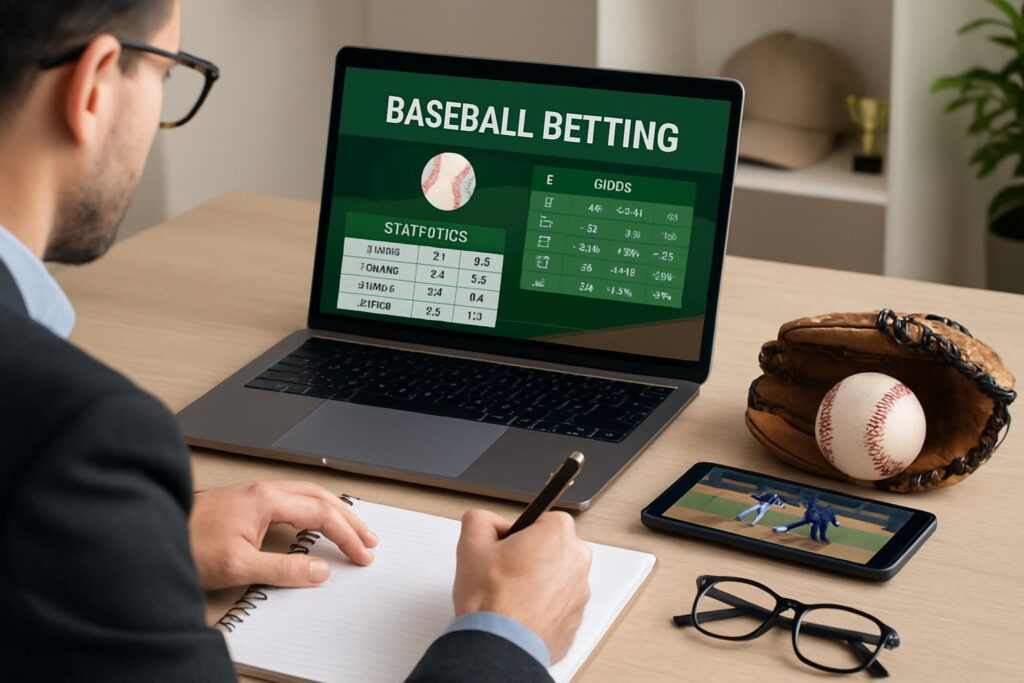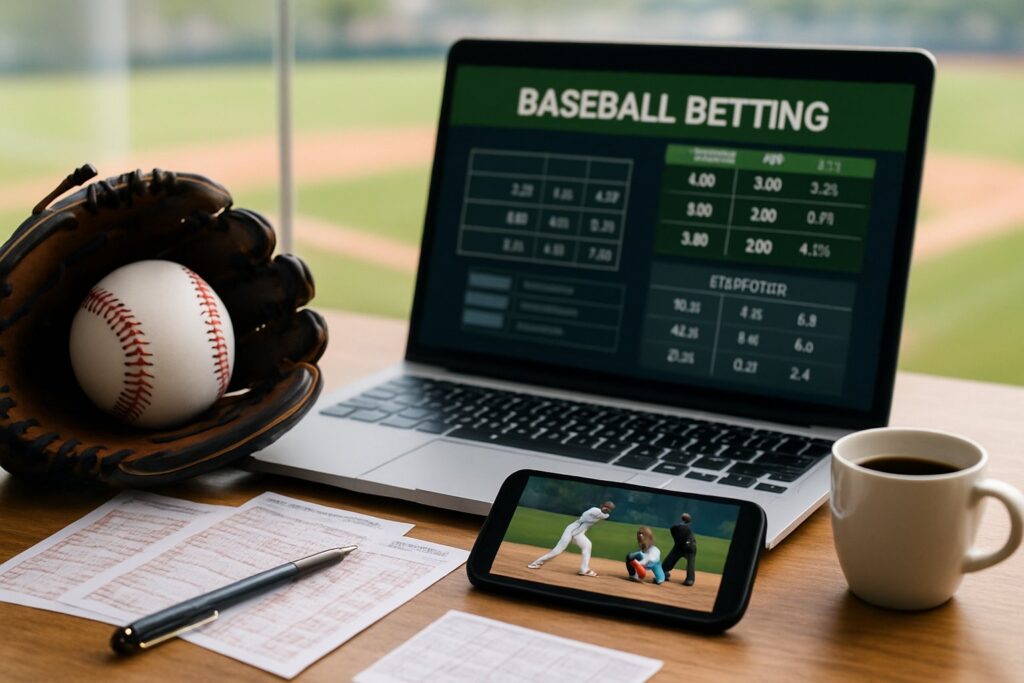by Martin Green
August 9, 2025
Last Updated on August 9, 2025 by Martin Green
Getting started with baseball betting means you’ve got to understand how the betting markets work. Odds, bet types, and the factors that shape outcomes all matter. To bet on baseball, pick a bet type – like moneyline, run line, or totals – then dig into stats, matchups, and conditions to make your picks.

You can bet on who wins, the margin of victory, or if the total runs go over or under a set number. There are also prop bets on player stats, parlays that combine outcomes, and futures if you want to predict season results. Every type has its own risks and rewards, so it’s smart to match your approach to what you’re after.
Guessing won’t get you far. If you want better results, study team and pitcher stats, keep an eye on injuries, and factor in things like ballpark quirks and weather. A plan and some discipline with your bankroll make betting more strategic – and keep things sustainable.

Baseball betting is all about predicting game outcomes, player stats, and scoring totals. You’ll see unique bet types like moneyline, run line, and totals – these work differently than point spreads in other sports. If you want to make smarter wagers, it helps to know how odds are set and which sportsbooks offer the best lines.
When you bet on baseball, you’re placing wagers on pro leagues like MLB, or even international leagues like NPB or KBO.
The most common bet is the moneyline – you just pick which team you think will win. Unlike football or basketball, MLB games usually don’t have a standard point spread.
Other popular bet types include:
With 162 games per team in the MLB season, there are tons of betting chances. But that also means more variables, like pitching matchups or weather, to keep track of.
Most MLB odds use the American odds format. Favorites get a minus sign (like -150), underdogs get a plus (like +130).
Example:
| Team | Odds | Bet $100 | Profit if Win |
|---|---|---|---|
| Yankees | -150 | $150 | $100 |
| Red Sox | +130 | $100 | $130 |
So, a -150 favorite means you’d bet $150 to win $100. A +130 underdog means you’d win $130 from a $100 bet.
Sportsbooks set odds based on their read of each team’s win probability and tweak them for market demand. Comparing odds at different sportsbooks can help you find better value, especially in tight matchups.
Lots of licensed sportsbooks offer solid online baseball betting markets.
The most popular in the U.S. are:
Each sportsbook sets its own lines, so odds can vary. Opening accounts with a few lets you shop for the best prices and grab different promos during the season.

When you bet on baseball, you’re usually trying to guess the winner, the victory margin, or the total runs scored. Each wager type has its own format for odds, payouts, and risk, so it pays to know how they work before you jump in.
The moneyline is the simplest baseball bet. You just pick the team you think will win – no spread involved.
Sportsbooks show moneyline odds with a minus (-) for the favorite and a plus (+) for the underdog. The minus number tells you how much to bet to win $100. The plus number shows what you’d win from a $100 bet.
Example:
| Matchup | Odds | Bet Outcome |
|---|---|---|
| Yankees | -150 | Bet $150 to win $100 |
| Red Sox | +130 | Bet $100 to win $130 |
Favorites win more often, but pay less. Underdogs don’t win as often, but the payout is bigger. Moneyline betting is a fan favorite in baseball since games are often close and you don’t have to worry about covering a spread.
The run line is baseball’s take on a point spread, usually set at ±1.5 runs. You can bet the favorite to win by more than 1.5 runs, or the underdog to lose by less than 1.5 runs (or pull off a win).
Example:
| Matchup | Run Line | Odds | Bet Wins If… |
|---|---|---|---|
| Dodgers | -1.5 | +120 | Dodgers win by 2+ runs |
| Giants | +1.5 | -140 | Giants win or lose by 1 run |
Runline bets usually pay more than moneyline bets on favorites since you need a bigger win. For underdogs, it can be less risky – losing by a single run still works in your favor.
Totals bets are all about the total runs scored by both teams. The sportsbook sets a number, and you bet if the actual total will be over or under that.
Example: Over/Under 7.5 runs
Totals betting isn’t about which team wins. Instead, you look at starting pitchers, bullpen strength, weather, and ballpark size. If it’s a strong pitching matchup, totals tend to be lower. Hitter-friendly parks or weak pitching can push totals up.
You can bet on player or team performances instead of just the final score. Or, combine several bets into one for a shot at a bigger payout – though the risk jumps, too.
Player props are all about individual stats or achievements in a game.
For example:
These bets let you zero in on specific matchups or player trends. You might look at recent form, opponent stats, or even the ballpark to make your call.
Team props focus on how a team performs, but not the final score.
Examples:
If you’ve got good data on certain players or teams, prop bets can be handy. They add some variety to your betting and don’t rely on the full game result.
A parlay puts two or more bets together into one wager. All the selections – called legs – have to win or the whole thing loses.
In baseball, parlays might include moneylines, run lines, totals, or prop bets. For instance:
| Leg | Bet Type | Example | Odds |
|---|---|---|---|
| 1 | Moneyline | Yankees to win | +120 |
| 2 | Total Runs | Under 7.5 | -110 |
| 3 | Player Prop | Pitcher over 17.5 outs | -145 |
Parlays can pay out big because the odds multiply, but the risk goes up with each leg. It’s a balancing act between the potential reward and the lower chance of hitting every pick. Many folks use small parlays for fun and stick to single bets for steadier results.
These bets focus on things that get decided later in the season. You lock in your pick early, and the odds can change as teams rise or fall, injuries happen, or standings shift.
A futures bet is a wager on something that’ll be settled down the line, usually after the regular season or playoffs. In MLB, this could be the World Series winner, league champion, or player awards like MVP or Cy Young.
You can place these bets before or during the season. Odds move as teams win or lose, so timing can matter quite a bit. Betting early might get you a bigger payout if you nail the prediction.
Common MLB futures markets:
| Bet Type | Example Wager |
|---|---|
| World Series Winner | Dodgers to win the World Series |
| League Champion | Yankees to win American League |
| Division Winner | Braves to win NL East |
| Player Awards | Shohei Ohtani to win MVP |
Payouts use moneyline odds. So a +800 bet means you’d win $800 on a $100 wager if you’re right. Not bad, huh?
Season-long bets track performance across the entire 162-game schedule. One classic option is win totals, where you pick if a team will finish over or under a set number of wins.
There’s also playoff qualification bets, where you guess if a team makes or misses the postseason. These markets update as the season rolls on, so you can jump in mid-year if you spot an angle.
Another long-term play: statistical leader bets. You can bet on who’ll lead the league in home runs, strikeouts, or batting average.
Since these bets tie up your money for months, think about team depth, injury history, and the schedule before getting involved. A little research goes a long way when you’re looking for value.
Live betting lets you place wagers after the game’s already started, with odds that swing after every pitch, at-bat, or inning. It gives you more control since you can react to real-time events instead of relying on pre-game guesses.
Sportsbooks update odds in real time as the game unfolds. You might bet on the next batter’s result, total runs in an inning, or which team scores next.
Odds can move fast after big moments like a pitching change or a home run, so you have to act quickly if you see a price you like.
Common live betting markets include:
Once you’ve watched a few innings, you can get a real sense of how pitchers look, how defenses are lining up, and even how weather’s impacting the game. That extra info can help you make smarter bets than you might have before first pitch.
Keep an eye on pitcher performance. If a starter racks up a high pitch count early, he might struggle later, opening up chances for run totals or comeback bets.
Bullpen depth matters too. Teams with strong relievers usually protect leads, but a shaky bullpen can cough up runs late.
Game context is everything. For example:
| Situation | Possible Bet Opportunity |
|---|---|
| Close game, late innings | Bet on extra innings or small run totals |
| Hot offense facing tired pitcher | Bet on more runs in next inning |
Don’t chase losses by throwing down random bets. Try to focus on specific spots where your research and what you’re seeing actually line up with the odds.
Winning at baseball betting usually comes down to focusing on measurable stuff and reading the market. If you pay attention to pitching matchups, bullpen depth, and key stats, you’ll spot edges when the odds don’t quite match up with reality.
Starting pitchers set the tone for most games. Check their recent form, pitch counts, ERA, WHIP, and strikeout-to-walk ratios. If a starter just pitched on short rest or threw a ton of pitches last time out, he might struggle.
Bullpens can swing close games. Keep tabs on bullpen ERA, recent workload, and left/right splits. If a bullpen just worked a bunch of high-leverage innings, they’re more likely to give up late runs.
Try First Five Innings (F5) bets if you trust a starter but not the bullpen. This lets you focus on the matchup you liked and skip late-game chaos. Looking at both starters and relievers gives you a clearer idea of who can actually keep runs off the board.
Line moves often show where sharp bettors are putting their money. If odds shift fast, it could be because of lineup changes, weather, or injury updates. Track these moves across different books to grab better prices before everyone else catches on.
Underdogs can pay off since even the best MLB teams lose a bunch of games. Look for spots where the public overlooks a team – maybe a strong starter is up against a hyped but overrated opponent.
Always shop for the best odds. Even a small edge, like +135 instead of +125, adds up over time. Don’t just blindly back underdogs, though – make sure there’s a real reason for the play.
OPS (On-base Plus Slugging) combines how often a team gets on base with its power. It’s a handy single number for gauging offensive strength. Teams with a higher OPS usually have more scoring potential, especially if the opposing pitcher isn’t sharp.
Compare team OPS splits against left- and right-handed starters. A squad that crushes lefties but is average vs. righties might be a sneaky play in the right matchup.
Pair OPS with other stats like OBP and SLG for a fuller picture. These numbers help you spot when a team’s offense could surprise the market.
Baseball betting takes some know-how about odds, bet types, and how different game situations can affect outcomes. If you want to make smart picks, you’ll need to understand spreads, moneylines, and how different betting systems work.
Look for value, not just favorites. Check starting pitcher matchups, bullpen strength, and how teams have played lately.
Avoid chasing losses and try to stick to a consistent bet size so you don’t get in over your head.
The run line is baseball’s take on a point spread. One team is set at -1.5 runs and the other at +1.5 runs.
It changes the payout compared to a straight moneyline bet.
A -1.5 run line means the favorite has to win by at least 2 runs for your bet to cash.
If they only win by 1, or lose, your bet’s a bust.
Check how the starting pitcher’s been throwing, look at injury reports, and see how these teams have matched up recently.
Home-field matters, and so does how each team hits against lefties or righties.
Some folks use the fade the public strategy, betting against sides that are super popular.
Others watch for reverse line movement, where odds move toward the less popular pick, possibly showing where sharp money’s landing.
Try joining sports betting forums, following respected baseball analysts, and checking out in-depth previews on trusted sports news sites.
Social media groups and podcasts that focus on MLB betting usually share fresh insights and trends too.